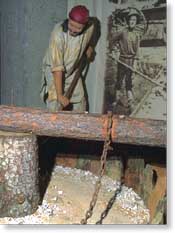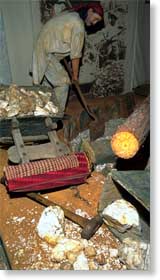  
Prospecting - Sonoran
Arrastra
Many of the 5000
Sonorans who came for gold had been miners in Mexico. They brought with them the tools and
techniques they had used successfully for generations.

Click icon to hear Sonoran
Arrastra en español
 Many Sonorans used a machine called an arrastra. A
mule, or the miners themselves, pulled the boom around the circle, dragging heavy stones
over the quartz ore to crush it. The miners then separated the gold from the pulverized
ore in wooden bowls called bateas. Many Sonorans used a machine called an arrastra. A
mule, or the miners themselves, pulled the boom around the circle, dragging heavy stones
over the quartz ore to crush it. The miners then separated the gold from the pulverized
ore in wooden bowls called bateas.
Foreign Miners Tax
Americans felt
threatened by the success of these experienced Sonorans. The first Foreign Miners Tax was
enacted by the California Legislature in 1850. It was directed specifically at
Spanish-speaking miners, and was more an attempt at driving them out than collecting
revenues.
Much has been
said of the amounts of gold taken by Sonorans, Chileans, and Peruvians, and  carried out of the country. This alarm is without
basis. The gold they mine all goes to the capacious pockets of the Americans - for
provisions, clothing, and the gaming-table.- Walter Colton carried out of the country. This alarm is without
basis. The gold they mine all goes to the capacious pockets of the Americans - for
provisions, clothing, and the gaming-table.- Walter Colton
Sonorans remained
the object of resentment and hatred by the Americans. Although many fought back initially,
most Mexicans left the gold fields by 1851 when faced with increasing violence and the
exorbitant taxes.
Top: Sonoran Assastra, Photo by Christopher
Richard
Bottom: Sonoran Rockpile, Photo by Christopher Richard
Chinese Camp | Arrastra | Miwok Mining Site | Coyote Hole | Long Tom |


 Many Sonorans used a machine called an arrastra. A
mule, or the miners themselves, pulled the boom around the circle, dragging heavy stones
over the quartz ore to crush it. The miners then separated the gold from the pulverized
ore in wooden bowls called bateas.
Many Sonorans used a machine called an arrastra. A
mule, or the miners themselves, pulled the boom around the circle, dragging heavy stones
over the quartz ore to crush it. The miners then separated the gold from the pulverized
ore in wooden bowls called bateas. carried out of the country. This alarm is without
basis. The gold they mine all goes to the capacious pockets of the Americans - for
provisions, clothing, and the gaming-table.- Walter Colton
carried out of the country. This alarm is without
basis. The gold they mine all goes to the capacious pockets of the Americans - for
provisions, clothing, and the gaming-table.- Walter Colton